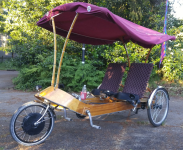I am in the design phase of an Electric Rickshaw/Golf cart type vehicle.
Must be able to carry two adults, will mostly be used to run around campgrounds and resorts, an auxiliary vehicle for our RV. Should mostly be flat ground occasional hills, mostly paved roads occasionally hard packed dirt or gravel, top speed 10 – 15 mph.
My design, not yet finalized will allow it to be easily disassembled to fit in an RV storage bay underneath.
Currently my design is to use 2, 48v 1500W 20 inch Fat Tire hub motors on the rear of a trike type vehicle.
Currently looking at these: 48V 1500W 20" Hub Motor
My Question, I have done quite a few searches and have not been able to locate the answer, I would like the Vehicle to have reverse, I see where some of the controllers do reverse, will most hub motors do reverse? and this function is applied by the controller? or does the Hub Motor have to be designed specifically to allow reverse?
In the beginning part of my build I will probably use the controllers that come with the hub motors, but have seen this dual motor controller with the reverse function. Dual Motor controller with reverse. Although this controller has the functions it is not up to the power requirements.
I have quite a bit of experience with and would like to use a 48V 100AH LifePO4 battery pack made up of a BMS and 16 cells like these. LifePO4 100AH Cells
Thank You in advance for any info.
I am pretty new at this, but have already built a Mongoose Mtn Bike with a Bafang BBS02 750 middrive that works really good.
Peter
Must be able to carry two adults, will mostly be used to run around campgrounds and resorts, an auxiliary vehicle for our RV. Should mostly be flat ground occasional hills, mostly paved roads occasionally hard packed dirt or gravel, top speed 10 – 15 mph.
My design, not yet finalized will allow it to be easily disassembled to fit in an RV storage bay underneath.
Currently my design is to use 2, 48v 1500W 20 inch Fat Tire hub motors on the rear of a trike type vehicle.
Currently looking at these: 48V 1500W 20" Hub Motor
My Question, I have done quite a few searches and have not been able to locate the answer, I would like the Vehicle to have reverse, I see where some of the controllers do reverse, will most hub motors do reverse? and this function is applied by the controller? or does the Hub Motor have to be designed specifically to allow reverse?
In the beginning part of my build I will probably use the controllers that come with the hub motors, but have seen this dual motor controller with the reverse function. Dual Motor controller with reverse. Although this controller has the functions it is not up to the power requirements.
I have quite a bit of experience with and would like to use a 48V 100AH LifePO4 battery pack made up of a BMS and 16 cells like these. LifePO4 100AH Cells
Thank You in advance for any info.
I am pretty new at this, but have already built a Mongoose Mtn Bike with a Bafang BBS02 750 middrive that works really good.
Peter



